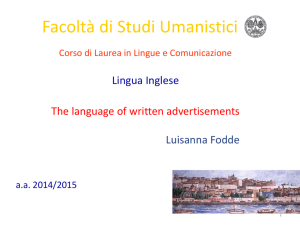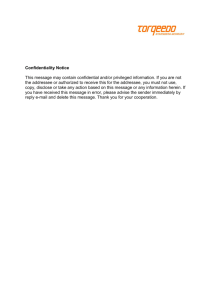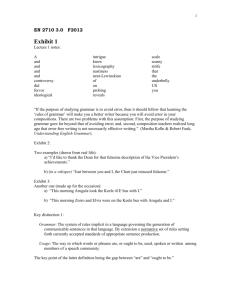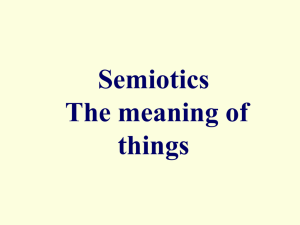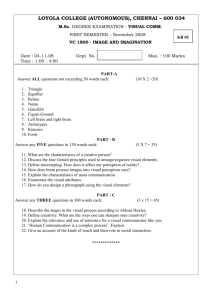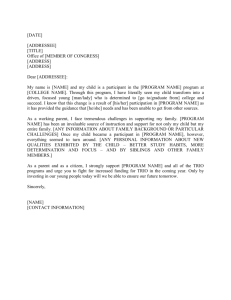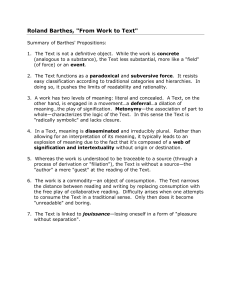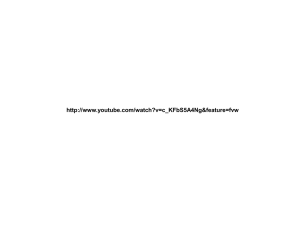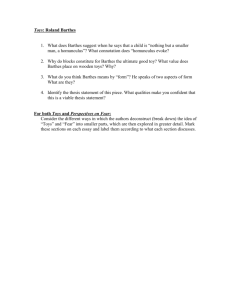The Visual Code
advertisement
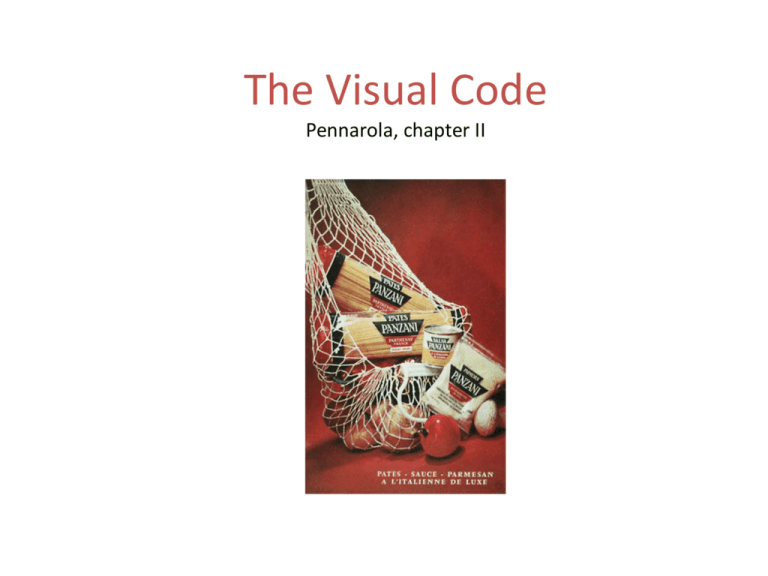
The Visual Code Pennarola, chapter II The Visual Code The title of Roland Barthes’s essay, Rhetoric of the Image, lays down the groundwork for the main argument of his essay, as the word “rhetoric” refers to language that is used to persuade or influence people; and the word “image” refers to a reproduction or imitation of the form of a person or thing. As such, the “rhetoric of the image” simply refers to images used to persuade or influence people. SEMIOTICS • Semiotics is the science which studies the relationship between meaning and signs. • In so far that language is a system of signs, it is studied by semiotics. Semiotics – Barthes Semiotics – Barthes These two dimensions are often presented as 'axes', where the horizontal axis is the syntagmatic and the vertical axis is the paradigmatic. The plane of the syntagm is that of the combination of 'this-and-this-and-this' (as in the sentence, 'the man cried') whilst the plane of the paradigm is that of the selection of 'this-or-this-or-this' (e.g. the replacement of the last word in the same sentence with 'died' or 'sang'). Whilst syntagmatic relations are possibilities of combination, paradigmatic relations are functional contrasts - they involve differentiation Semiotics – Barthes – The Food System An example of the syntagmatic relations and paradigmatic contrasts involved in Western menus: In the food system... one defines on the syntagmatic axis the combinations of courses which can make up meals of various sorts; and each course or slot can be filled by one of a number of dishes which are in paradigmatic contrast with one another (one wouldn't combine roast beef and lamb chops in a single meal; they would be alternatives on any menu). These dishes which are alternative to one another often bear different meanings in that they connote varying degrees of luxury, elegance, etc. (Culler 1985, 104). Semiotics – Barthes Roland Barthes (1967) outlined the paradigmatic and syntagmatic elements of the 'garment system' in similar terms. The paradigmatic elements are the items which cannot be worn at the same time on the same part of the body (such as hats, trousers, shoes). The syntagmatic dimension is the juxtaposition of different elements at the same time in a complete ensemble from hat to shoes. Semiotics – Barthes (2) • Sign = Signifier + Signified • SIGNIFIER = physical representation of a thing or of a concept. It is the EXPRESSION. • SIGNIFIED = meaning. It is the the CONTENT. • CONTENT may be: – denotative (the ‘brain’ definition) – connotative (the ‘deeper’ meaning - see, for ex., the word ‘dog’). • The arbitrary nature of the sign is used deliberately in 57dow, where the word green is presented against a red background, which creates an advertisement that is quite confusing to the reader. • Upon investigation, we learn that the "green" is the green which is culturally associated with envy---your friends will envy you your Dow carpet product. Semiotics – Barthes (3) • Objects have meanings. • Such meanings may be: – symbolic (= connotative meaning) • they have a metaphorical meaning – taxonomic (=denotative meaning) • they are included in a system where things are named and organized. • They are classified. Barthes and the Rhetoric of Images Semiotics – Barthes (4) • Objects, regarded as symbols, have connotative meanings • Connotative meaning of objects can be: – Existential • Related to life but with non-human elements – market – Aesthetic • Related to design – for instance, still nature – Technological • Related to technology – i.e., when the object is useful for something else SEMIOTICS – PEIRCE (5) • There are three categories of denoting expressions or objects: • (1) ICON = direct visual representation of the signifier. • (2) SYMBOL = arbitrary relationship between the signified and the signifier. No link to what they represent. ‘Words’ are symbols. They have nothing to do with the thing they represent. • (3) INDEX = existential relation between two signifieds . Stable collocation with the entity it denotes. A sign/indication related to the object it represents. – for example, if I say ‘smoke’ I indicate the existence of ‘fire’ and create a relationship between the two signifieds. – Facial expressions indicating emotions – A knock on the door ‘indicates’ someone is arriving – Metonymic relationship (Hollywood, Palazzo Chigi, The White House) ICON (direct visual representation) SYMBOLS • Symbols are conventional expressions for the culture that has created them • Arbitrary relation between signifier and signified Symbol, Index and Icon Alcohol advertisements tend to depict wealthy living and sex appeal by characterizing the alcohol consumers as such. Symbol=O=Orange= Bacardi Orange Bottle= Icon Index= Alcohol INDEX Existential relation between 2 signified Stable collocation with what it denotes INDEX – PEIRCE (5) An index in an advertisement is generally quite culturally-bound, representing something by association. A typical example might be: a head of a wealthy-looking woman in a diamond advertisement (an index for a wealthy lifestyle) We are unlikely to see three laughing teenagers in a diamond advertisement, or the head of a glamorous woman in a disposablecamera advertisement. INDEX – PEIRCE (5) These indexical components of advertisements have connotations, which typically connect the advertisement to a larger cultural context. Symbols and Indexes • In terms of cultural significance, a company is well-served if its symbol becomes an index – a signifier goes beyond what it directly signifies to some larger association. The McDonald's "Golden Arches" The Golden Arches are the symbol of McDonald’s, the global fast-food restaurant chain. Originally, real arches were part of the restaurant design. They were incorporated into the chain's logo in 1962, which resembled a stylized restaurant, and in the current Golden Arches logo, introduced 1968, resembling an "M" for "McDonald's". The symbol of McDonalds has come to be indexical over time. This represents a very strong cultural establishment of the symbol. Of course, it is a very powerful marketing tool. To summarize, within an advertisement, the image component may have some part that is iconic to the product, and there may be some symbols such as a company logo, and so on. The overall image may have some cultural associations, which are indexical to some larger cultural context. Symbol or Index? In this example from a men's magazine, the image suggests that Smirnoff enables you to see that women (or perhaps some women) are nutcrackers ……. (the code of related Smirnoff ads marks this as humour). ?????? The Media Iceberg Symbol (Text/visual) common (unsaid) knowledge background assumptions: stereotypes; thought/ideas against social norms; discrimination; sexist and racial statements Text • In advertisements, a great component is the text. • What is the main purpose of the text? • Advertising language has to be adapted to the needs of the consumers Language of advertising • Informative language – factual, realistic, objective – Symbolic relation between the brand, the product and its qualities • Consumer language – Catchy, creative, glamorous – Metaphors, analogies, imagery, idiomatic, colloquial and informal expressions • What is language? • Social behaviour to satisfy needs – Once: food/safe shelter – Now: security/money/comfort => necessity to belong/to be identified to a social group Jakobson’s linguistic factors context message addressee addresser code contact Jakobson’s linguistic factors Jakobson argues that every oral or written verbal message or ‘speech act’ (parole) has the following elements in common: • the message itself, • an addresser, an addressee, • a context (the social and historical context in which the utterance is made), • a contact (the physical channel and psychological connection that we find between addresser and addressee), • a code, common to both addresser and addressee, which permits communication to occur. Addresser & addressee in ad • What in Jakobson’s theory is defined as the ADDRESSER in ad language is the WRITER, SENDER, PRODUCER • What in Jakobson’s theory is defined as the ADDRESSEE in ad language is the READER, RECEIVER, CONSUMER • THEREFORE we do not have a simple addresseraddressee relationship because ad language has complicated purposes • Ad language obeys to the marketing laws • It MUST persuade the consumer to buy. – => linguistic rhetorical devices • ≠ styles and ≠ narrative viewpoints • We therefore have the relation: NARRATOR NARRATEE Narratee =YOU • YOU in ad language exploits the psycholinguistic potentiality: • it awakes our sleeping ego, as YOU is our ego seen by others • It also suggests the idea that some of US is able to say YOU though feeling to be similar to the US • In English, the pronoun YOU has an ambiguity which is unknown in other languages, as YOU is both singular and plural. Jakobson’s linguistic factors context message addressee addresser code contact Jakobson’s linguistic functions These six elements or ‘factors’ of communication are aligned each with a different ‘function’ of language as follows: Emotive Referential (context) Poetic (message) Conative (addresser) (addressee) Metalingual (Code) Phatic (contact) Jakobson’s linguistic functions Briefly, these six functions can be described as follows: (1) the referential function is oriented toward the context (the dominant function in a message like 'Water boils at 100 degrees‘. What the message is about); (2) the emotive function is oriented toward the addresser (as in the interjections 'Bah!' and 'Oh!'); (3) the conative function is oriented toward the addressee (imperatives and apostrophes); Jakobson’s linguistic functions (4) the phatic function serves to establish, prolong or discontinue communication [or confirm whether the contact is still there] (as in 'Hello?'); (5) the metalingual function is used to establish mutual agreement on the code (for example, a definition); (6) the poetic function (e.g., 'Smurf'), puts 'the focus on the message for its own sake‘. Not the message but the form of the message. (Jakobson, 1960, p. 356) Referential - when referential, the stress is on the message’s denotative or cognitive purpose (what the message is about). The body copy presents the product characteristics Emotive (these are my emotions) When a message is emotive in function, it is designed to stress the addresser’s response to a given situation arising in the context; Conative (The stress is on the message’s impact upon the addressee) The ad prompts Phatic (Attracts reader’s attention, checks the channel to go on with conversation. The emphasis is on establishing that given channels of communication are open and unimpeded) Metalingual (can you explain it any better?) - when metalinguistic, the stress is on the code itself shared by addresser and addressee, that is, the medium in which communication occurs, Poetical (we play with language). when poetic / aesthetic, the stress is on the form of the message itself. poetic AD as a persuasive discourse A successful ad responds to the ARMS characteristics (Leech, 1966): Attention seeking devices (images, paralanguage, linguistic violations) Readability (simple, personal, colloquial style, and familiar lexis) Memorability (slogan, key phrases, repetitions, alliteration, rhyme, rhythm) Selling Power (direct appeal to customers : try, taste, go, imperative forms) To achieve success, advert language must therefore be PERSUASIVE Attention Seeking Devices Startling images Paralanguage • It supports our verbal language. • In face-to-face interaction: – Linguistic Stress and intonation – Body position – Gestures – Physical proximity – Clothing – Eye contact – Touch Paralanguage • In written communication: – Layout – Typographical features – Space Graphological features HANDWRITING Typograhical setting as a form of paralanguage (1) Different fonts (Haettenschweiler) Different fonts (Times New Roman) Different fonts (Courier New) Different fonts (Curlz) Typograhical setting as a form of paralanguage (2) • Different sizes (32 point) • Different sizes (48 point) •Different sizes (60 pt) Typograhical setting as a form of paralanguage (3) • Different styles (emboldened) • Different styles (Italics) • Different styles (underlined) • Different styles (emboldened underlined italics) • Normal vs. Different styles (Apex) • Normal vs. Different styles (Pedix) Typograhical setting as a form of paralanguage (4) • CAPITAL LETTERS (UPPERCASE) • small letters (lowercase) • and… features of punctuation? • and – features of punctuation! • and: ‘features’ of punctuation; • and features of ‘punctuation’. The letters in the ads may assume different shapes and even be replaced by the icons of people or things, blurring the iconic and the verbal constituents of the ad “Emina Uzicanin was just 5 years old. Her family was living on the outskirts of Sarajevo. On a sunny afternoon in May, Emina was playing in a field behind her Uncle’s house. There, she spotted two little rabbits. As soon as she started toward them, the rabbits took off. So she began running. Five feet. Ten feet. That’s when it happened. An ear-shattering explosion ripped through Emina’s body, severing her left leg and leaving the rest of her badly scarred. Every 22 minutes another innocent civilian is killed or maimed by a land mine. Right now there are over 60 million unexploded land mines waiting just beneath the earth in nearly 70 countries. We need your help to rid the planet of land mines and to help its victims like Emina.” http://www.ncddr.org/products/researchexchange/v07n03/9_mines.html COLOURS • Yellow: Mental activity, intellect. • Red: Joy, aggression, animal passion, fun. • Blue: Spirituality, religion, art, culture, philosophy, attitude to life itself. • Green: harmony, nature, feeling of fullness. • Orange: Drive, ambition. • Purple: power, leadership, respect • Pink Love • Grey Meaning : Uncommitted, uncertain - ‘grey area’. Mental denial of emotion, depression. • Brown: Earthy, practical • White: Hope, faith, purity, perfection, confidence, enlightenment • Black: Negativity, i.e. fear, anxiety, hatred, resentment, guilt, depression (no hope / faith). Attention seeking devices : spelling deviations Brand names: Kleenex (Kleen); Rice Krispies (Krispier), Kwick Save supermarket (Kwick & cheap); Zurich: Because change happenz Iconicity of letters: B different (Bally) Radiance you can C. (Lancome) Attention seeking devices : Punning Attention seeking devices : Punning A pun is a wordplay based on the double meaning of a word which results in a phonetic or lexical misunderstanding… “Anywear. Don’t put a foot wrong” (Knickers) “At last, someone’s made scent of the world” (Haze world scents) “NEED A JOB? LETS TACO BOUT IT!” Activities 1. Can you explain? (wordplay) a) b) c) d) e) f) g) h) i) j) RU (Rimmel make up) Pampers (nappies) Huggies (nappies) Oust (air freshner) Coco Pops (cereals) FCUK (clothing) Sunsation (suntan cream) VitalEyes (eye drops) Weetabix (wholegrain biscuits) wheat Bare necessities (underwear) Activities 1. Can you explain? (phonetic /lexical puns) a) Fuji Film: loaded with innovation b) When shoes have a soul: Berlutti Bottier depuis 1895 c) Horlickzzzz: www.sleepbetter.co.uk d) Ariel colour: that’s another load off your mind e) FIAT: Driven by passion f) LEXUS: Moves you in more ways than one g) Sunsation (suntan cream) h) LabSeries Skincare for men: Face the day Readability : oversimplified grammar …phew* You can now buy the emergency contraceptive pill from the pharmacy. It’s called Levonelle and works best within 24 hours but can be used up to 72 hours after unprotected sex.
